An Unscientific Comparison of News Websites - Part 2 (Objective Analysis)
14 Mar 2021 critique · journalism · media · newsThis series of posts looks at 13 news website home pages and compares them at a single point in time, based on the content that they host and the presentation of that content to the common user. This is the second post in this series and it looks objectively at the content and classification of the articles on each web page. We look at the various websites and try to classify why some news websites are clearly “good” while others are “tolerable” at best.
Programming note: (Post 1: released yesterday, Post 2: this post, Post 3: March 15)
After counting and classifying each news article on the News home pages, I eyeballed the data and some graphs. I came up with three insights that I think are instrumental in making a website good, based on the kind of content.
Quality and quantity are equally important (for the most part, anyway)
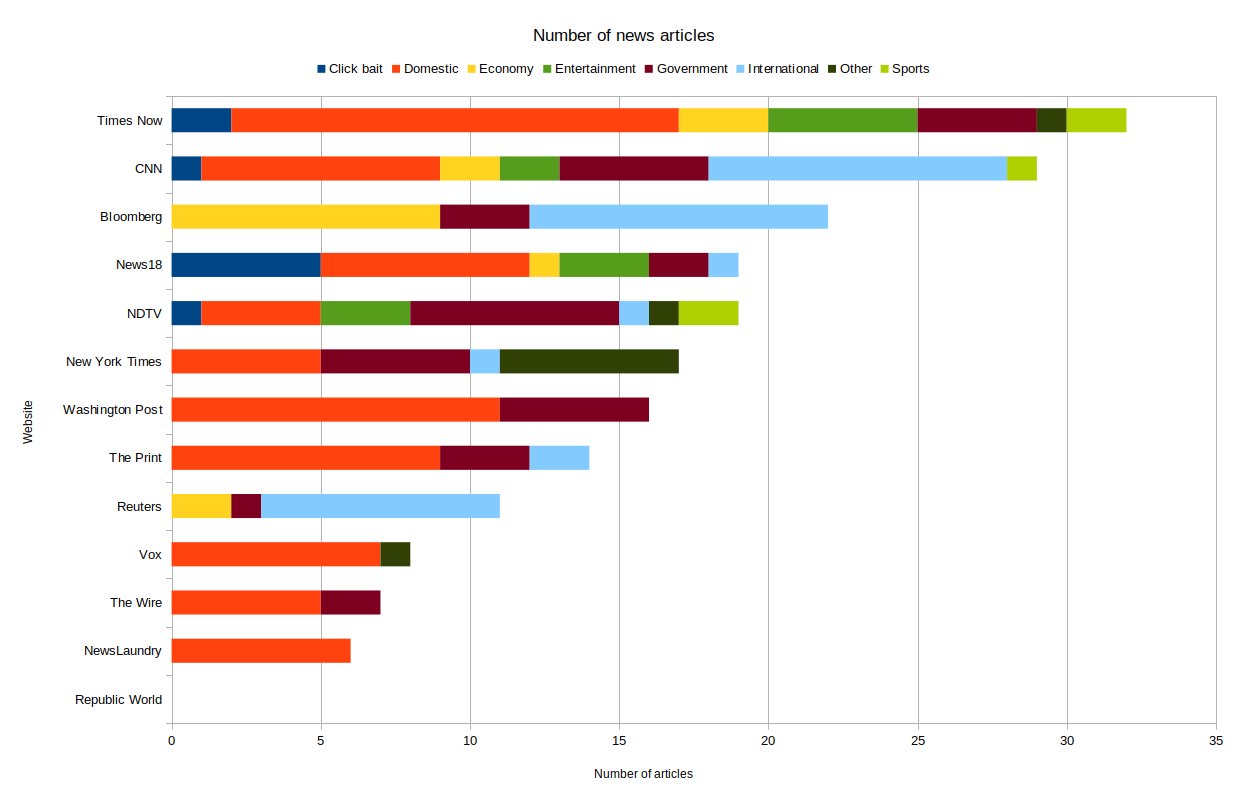
I was surprised by the results, but then I realized that Times Now seemed to be winning simply because they had crammed a huge amount of news articles onto the available space on their website. To penalize the websites that put articles on their site as fillers for the available space, I added a negative weight to 2 categories: Entertainment articles get a weight of -1 and Click bait articles get a weight of -2. All other articles get the same weight (= 1).
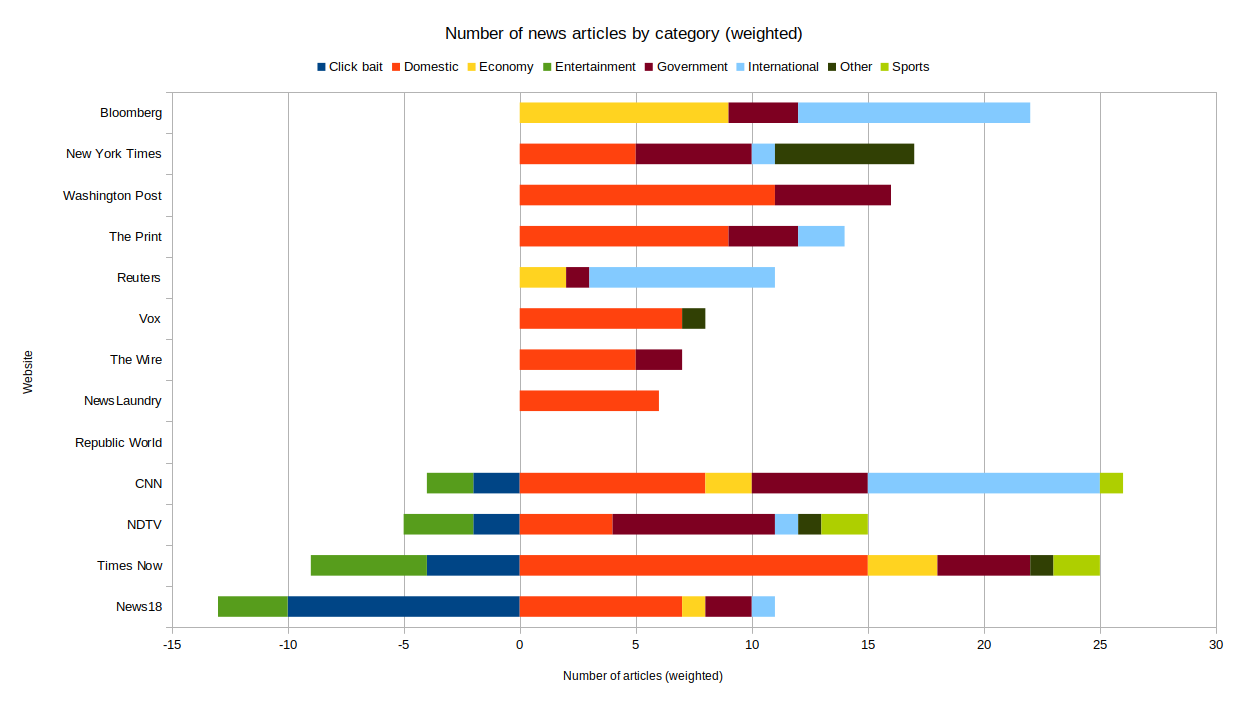
If one looks at the weighted score, i.e. the sum of all news articles after subtracting the penalties for including entertainment and clickbait articles on the home page, the websites reorder themselves and the reputed websites clearly show their higher caliber.

Interestingly, even in this ordering, Times Now is quite high, scoring the same as the venerable Washington Post and slightly less than the paper of record, The New York Times.
The key insight here is that quality and quantity go hand-in-hand. Websites like Bloomberg and NYT put a lot of information on the home page, which in turn lets the user decide what path they want to follow into the website. They don’t clutter their home page with Entertainment or Clickbait. They give the user a wide variety of content and statistically increase the chances that a reader will find something of interest and stay on the site. Times Now chooses the same strategy but mixes in a few clickbait-y articles. If you want to put clickbait on your home page, be sure to cram it as much as possible with non-clickbait, quality content to retain the experience of the serious visitor. Don’t be a tabloid website is a succinct expression of the same thought (A sample tabloid website).
New-age websites like Vox and Newslaundry go for quality-only and put a select few articles on their home page. For instance, Newslaundry, the Indian new-age mediahouse, only puts 6 articles on the homepage. In my opinion, this is an inefficient use of expensive space on the homepage. Any potential subscriber who comes to the homepage must be presented with about 10-15 news articles from a variety of genres increasing the chances that they are able to find at least one article that will lead to them clicking and reading it. Obviously, the more time they spend on the site, the higher the chances that they becoming a returning visitor or a subscriber.
Websites cater to their audience
Looking at just the non-entertainment and click-bait articles, the target audience of each website can be guessed fairly reliably.
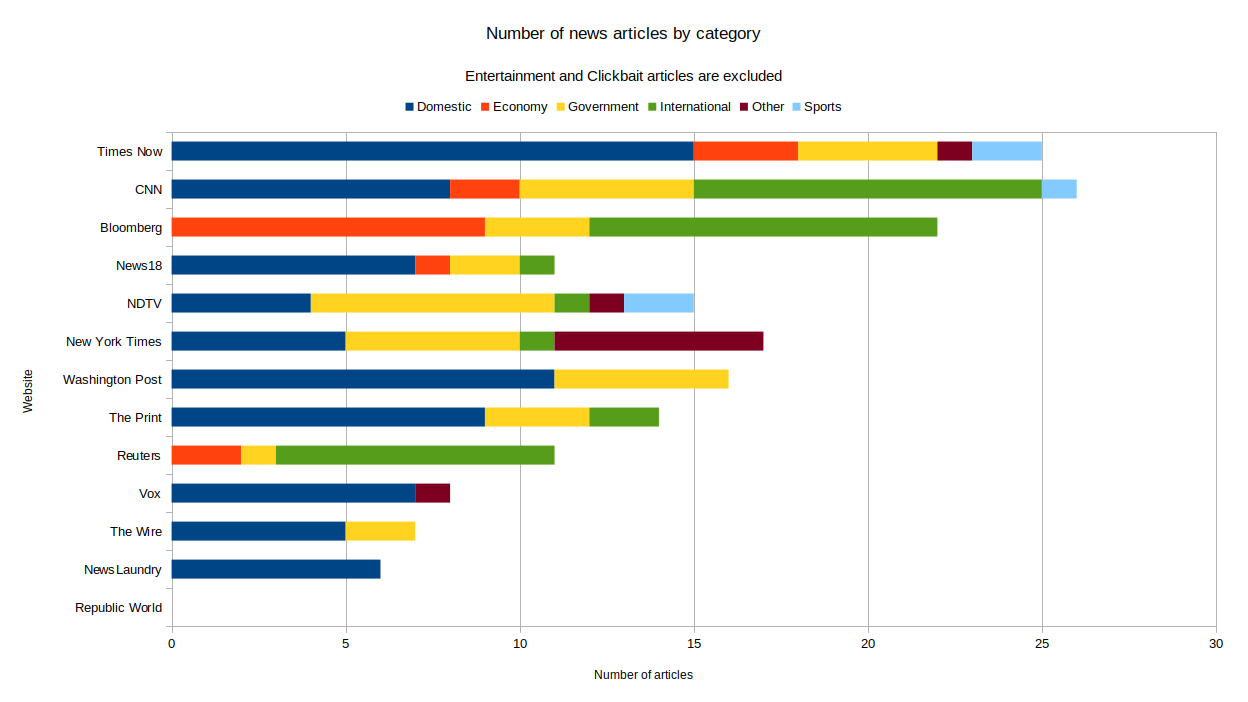
Bloomberg has the most stories in the Economy category, while CNN and Washington Post have the most stories in the Domestic and Government categories. NYT has a dedicated “Opinion” section on it’s right sidebar, denoting the exalted place occupied by Opinion columnists in the NYT world. Strikingly, new-age news websites don’t feature much variety on their website. Vox has a wide catalog and on their YouTube channel, they have explored a huge variety of subjects. But they have chosen not to highlight this on their homepage, deciding to stick to Domestic stories from the US and Opinion columns. Newslaundry and The Wire also stick to old-fashioned Domestic and Government stories, rather than using their autonomy to their advantage.
Also, it is clear that most websites based outside India don’t highlight sports on their home page at all. This is perhaps due to the tendency of sports fans to get their news from hyper-focused Sports sites, rather than plain-old news sites. The advantage of putting Sports stories on the home page is debatable for NDTV and Times Now. They should probably add a prominent link to their Sports section in the navigation bar and remove any Sports stories from their home pages.
None of the websites have too much clickbait
Looking at the Entertainment and Clickbait articles, it is clear that none of the websites have too much clickbait. This was a surprising finding.
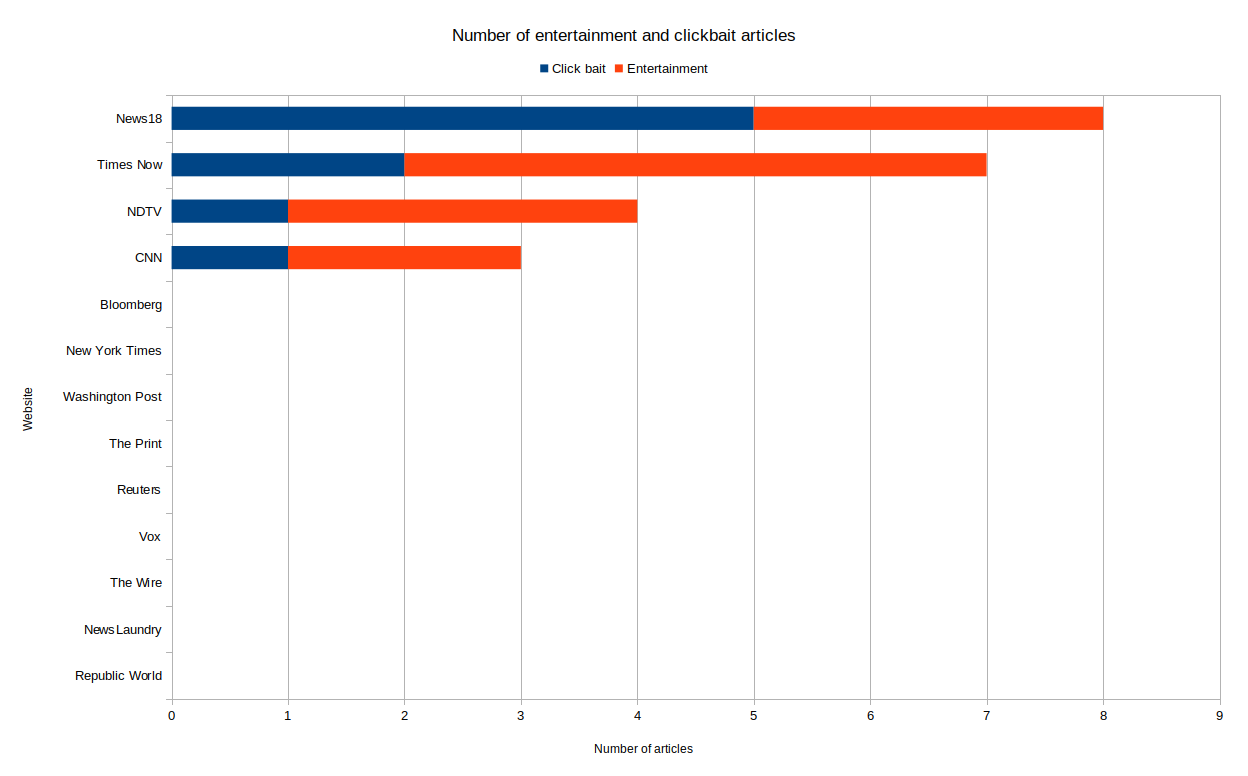
As a percentage of the total stories on the website, the number looks even better. Even the worst website, News18, uses only 25% of the available space for these articles.
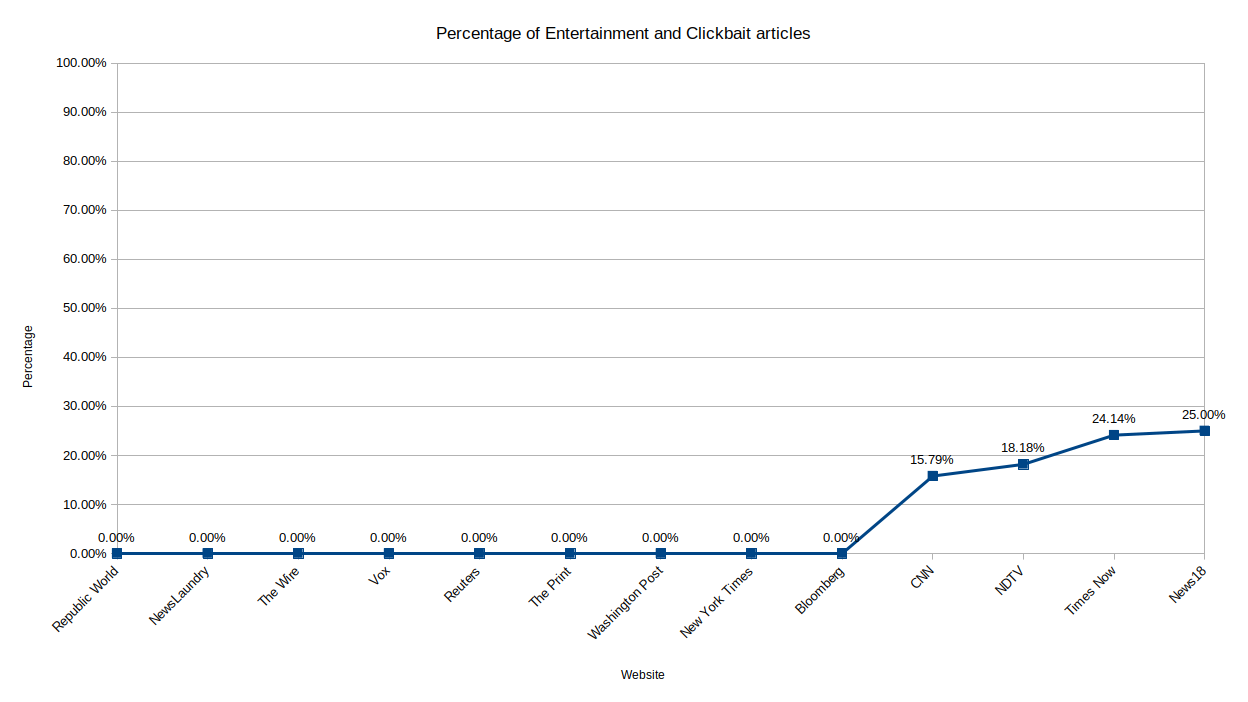
Now, far be it from me to declare that media houses understand that clickbait is annoying and that they are trying their best to balance the Click-Through Rate and Clicks Per Million dollar figure against their instinctive ideal to do good journalism and report on stories that the reader will find useful, especially when the reader next finds themselves in a voting booth. Fortunately, even the most pessimistic reading of these numbers leads me to believe that clickbait does not make up the majority of articles that these media houses publish on the Internet. This indicates at the remote possibility that the TV production crew at these media houses is more focused on producing sensational coverage when compared to the newsroom.
P.S. I am writing this article on 14th March, 2021, just as the Oprah interview with Harry and Meghan news story is picking up steam. All the major media houses have written almost identical news articles on the topic. There’s very little information left to share with readers who are just waiting for the other shoe to drop. The coverage of this story has been surprisingly low-key and levelheaded. Bloomberg ignored the story, while Vox and NYT published opinion and detail pieces about some of the words that Meghan used in the interview, while India’s NDTV published a snarky opinion piece from Shobaa De. It is unclear at this point which of the following scenarios will play out:
- The story has not caught on yet
- I am not checking the right places (Twitter, the town square where ignorant spectators have a lively, informed debate)
- The story will never become too big because it’s just not as interesting when people are stuck at home and looking for an adrenaline rush (like the one from stock trading), rather than a gossip story, which they used to simmer down and get away from stress in the past
- I am way off the mark and the story is not being reported in a “low-key, levelheaded” fashion
I am attached to option (3) above and would prefer it to be the case.